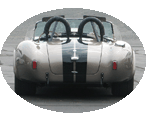 
 Main Menu
Main Menu
|
 Nevada Classics
Nevada Classics
|
 Advertise at CC
Advertise at CC
|
 February 2025
February 2025
|
| S |
M |
T |
W |
T |
F |
S |
| |
|
|
|
|
|
1 |
| 2 |
3 |
4 |
5 |
6 |
7 |
8 |
| 9 |
10 |
11 |
12 |
13 |
14 |
15 |
| 16 |
17 |
18 |
19 |
20 |
21 |
22 |
| 23 |
24 |
25 |
26 |
27 |
28 |
|
|
 CC Advertisers
CC Advertisers
|
|

06-28-2014, 11:49 AM
|
 |
CC Member

|
|
|
Join Date: Apr 2009
Location: Little Rock area,
AR
Cobra Make, Engine: ERA Street Roadster #782 with 459 cu in FE KC engine, toploader, 3.31
Posts: 4,527
|
|

 Not Ranked
Not Ranked
 Strange tuning response on my engine?
Strange tuning response on my engine?
See what everyone makes of this. I noticed the last time I adjusted my idle mixtures and idle speed that when I pulled the cap off the vacuum port on the carb to hook up the vacuum gage - the rpm increased??
I replaced my S&H filters with K&E filters and re-adjusted today and had the same result - although I think to a lesser degree. After adjusting the idle mixtures (primarily by rpm but also checking engine vacuum) I experimented with pulling the vacuum cap off on each carb individually and the rpm increased 100 rpm with open vacuum port. I adjusted the carbs using the same carbs vacuum port as a precaution. And I made sure the choke was wide open.
This is the first engine I've run in a long time without vacuum advance - I'm used to the engine speed falling when I pull a vacuum hose loose but that is due to loss of vacuum advance. If the engine speed increases with open vacuum port that would seem to indicate it's set too rich?? But why wouldn't the idle mixture screws correct for that. The engine seems to respond normally to idle screw adjustments. Vacuum at 850 rpm idle is 13 - 13.5.
Any thougths? Much ado about nothing? Seems to be running fine but I don't have many miles on the engine yet.
Forgot to add - 459 FE with 427 LR dual quad intake and 600 Holleys, medium hydraulic cam, worked steel heads and 9.1 compression.

|
-
Advertising


06-28-2014, 03:29 PM
|
 |
Senior Club Cobra Member

|
|
|
Join Date: Nov 2003
Location: Parker County,
Tx
Cobra Make, Engine: LoneStar LS427 , 427 Windsor
Posts: 381
|
|

 Not Ranked
Not Ranked
When you remove the vacuum cap you are increasing the amount of air that is going into the engine. Even though the fuel/air mixture is no longer "ideal", there is more of it.
__________________
Jim
------------
A Gnat! Quick, get a sledgehammer!
|

06-28-2014, 03:39 PM
|
 |
CC Member

|
|
|
Join Date: Apr 2009
Location: Little Rock area,
AR
Cobra Make, Engine: ERA Street Roadster #782 with 459 cu in FE KC engine, toploader, 3.31
Posts: 4,527
|
|

 Not Ranked
Not Ranked
Hmmm - is it that simple? I have to admit that makes sense. I'm so accustomed to engine rpm dropping when I pull the vacumm advance line off for my gage due to the timing fall out, I was kind of startled when rpm jumped up on my non-vacuum advance distributror.
So, much ado about nothing.
Thanks
|

06-28-2014, 05:05 PM
|
 |
Half-Ass Member

|
|
|
Join Date: Jun 2005
Cobra Make, Engine: ERA #732, 428FE (447 CID), TKO600, Solid Flat Tappet Cam, Tons of Aluminum
Posts: 22,017
|
|

 Not Ranked
Not Ranked
Quote:
Originally Posted by DanEC

Hmmm - is it that simple? I have to admit that makes sense. I'm so accustomed to engine rpm dropping when I pull the vacumm advance line off for my gage due to the timing fall out, I was kind of startled when rpm jumped up on my non-vacuum advance distributror.
So, much ado about nothing.
Thanks
|
OK, last year I was at a Ford festival and was chatting with a Ford technician who was deep in to his seventies. He said the way they adjusted the carbs at the dealer on the original 427 4-V cars was to adjust the idle mixture screws the exact same amount on each side so that when you pulled the cap off the manifold vacuum the idle did not go up, nor did it go down. He said "try it and see." I've used a vacuum gauge to adjust my carb for decades, but last year I did just as he suggested -- and I have to say my engine has never run better.  |

06-29-2014, 05:08 AM
|
 |
CC Member

|
|
|
Join Date: Apr 2009
Location: Little Rock area,
AR
Cobra Make, Engine: ERA Street Roadster #782 with 459 cu in FE KC engine, toploader, 3.31
Posts: 4,527
|
|

 Not Ranked
Not Ranked
Patrick - I'm not sure I understand how that would work? If the idle is jumping up because of additional air pulled in through the vacuum circuit below the butterflies when uncapped - how would it ever be able to be equalized? What did you do other than just back your mixture screws out equally by 1-1/2 turns, or 2 turns, etc?
|

06-29-2014, 06:27 AM
|
 |
Half-Ass Member

|
|
|
Join Date: Jun 2005
Cobra Make, Engine: ERA #732, 428FE (447 CID), TKO600, Solid Flat Tappet Cam, Tons of Aluminum
Posts: 22,017
|
|

 Not Ranked
Not Ranked

Quote:
Originally Posted by DanEC

Patrick - I'm not sure I understand how that would work? If the idle is jumping up because of additional air pulled in through the vacuum circuit below the butterflies when uncapped - how would it ever be able to be equalized? What did you do other than just back your mixture screws out equally by 1-1/2 turns, or 2 turns, etc?
|
My traditional vacuum gauge method was to adjust the mixture screws to achieve the highest vacuum at idle. That worked reasonably well. But, with a large overlap cam, vacuum is low and the response of the gauge needle is not instantaneous.
The old Ford service tech's method is, at least on the internet, almost totally undocumented. The only doc I could find that said the same thing was Tip #3 here: 12 Carb and Fuel System Tech Tips - Muscle Car Review Magazine
Now, I will say the "pull the vacuum plug" method gives you instant feedback. It was exceptionally easy, it resulted in different idle mixture settings from what I had with the vacuum gauge, and my car runs astoundingly well adjusting it his way. For me, and my setup, that is the way I will always do it from now on. It may not work for others. The only reason he mentioned it to me was that, after we chatted for a while, he remembered the specs of my original Ford "K" cam, along with a single four barrel, and how they dealt with getting the carb set just right when the cam was causing a lumpy, low vacuum idle.
I must admit that, at the time, I did not think his technique had any merit. But testing it out was as easy as pie.... |

06-29-2014, 10:36 AM
|
 |
CC Member

|
|
|
Join Date: Apr 2009
Location: Little Rock area,
AR
Cobra Make, Engine: ERA Street Roadster #782 with 459 cu in FE KC engine, toploader, 3.31
Posts: 4,527
|
|

 Not Ranked
Not Ranked
No. 3 goes back to my original question - is the idle mixture too rich? I guess I can experiment with leaning it down and see if the rpm jump lessens when I uncap the vacuum port.
|

06-29-2014, 01:16 PM
|
 |
Half-Ass Member

|
|
|
Join Date: Jun 2005
Cobra Make, Engine: ERA #732, 428FE (447 CID), TKO600, Solid Flat Tappet Cam, Tons of Aluminum
Posts: 22,017
|
|

 Not Ranked
Not Ranked

Quote:
Originally Posted by DanEC

No. 3 goes back to my original question - is the idle mixture too rich? I guess I can experiment with leaning it down and see if the rpm jump lessens when I uncap the vacuum port.
|
If you pull the cap off the manifold vacuum, and you hear it sucking clean air through the little tube, and the RPM jumps up, then "yes" your mixture was not at the optimal level for idling, it was a little rich -- but maybe your engine might like a little rich mixture -- I don't know. Now remember, my car doesn't have a vacuum advance but, obviously, if you're changing your timing by pulling the vacuum feed off the distributor that runs to your manifold vacuum then that would have to be taken in to account. If I had a vac advance distributor, I would just isolate that out of the equation by plugging it off while I adjusted the carb. I guess they didn't have exhaust gas analyzers at the Ford dealerships in 1963? Anyway, this is not a tough test to perform. And if it doesn't work for you, just go back to whatever method it was that you were using before. Of course, you should perform all your testing and adjusting with the air cleaner on. |

06-29-2014, 05:23 PM
|
 |
CC Member

|
|
|
Join Date: Apr 2009
Location: Little Rock area,
AR
Cobra Make, Engine: ERA Street Roadster #782 with 459 cu in FE KC engine, toploader, 3.31
Posts: 4,527
|
|

 Not Ranked
Not Ranked
I'm using an old 427 dual point distributor - it doesn't have vacuum advance. But with dual quads getting everything dialed in at idle is a bit more of a chore. But overall it seems pretty responsive and running fine - nothing really wrong with it.
|

06-29-2014, 06:03 PM
|
 |
Senior Club Cobra Member

|
|
|
Join Date: Nov 2003
Location: Parker County,
Tx
Cobra Make, Engine: LoneStar LS427 , 427 Windsor
Posts: 381
|
|

 Not Ranked
Not Ranked
Many "cammy" engines like a slightly rich idle to reduce off-idle bog at a speed where the big cam reduces the engine's efficiency. The acceleration pump simply isn't quick enough to cover it all.
With such an idle mixture, opening a small vacuum leak would speed the engine up.
__________________
Jim
------------
A Gnat! Quick, get a sledgehammer!
|

07-02-2014, 02:39 AM
|
 |
CC Member

|
|
|
Join Date: May 2008
Location: Brisbane,
QLD
Cobra Make, Engine:
Posts: 2,797
|
|

 Not Ranked
Not Ranked
Quote:
Originally Posted by Barnsnake

Many "cammy" engines like a slightly rich idle to reduce off-idle bog at a speed where the big cam reduces the engine's efficiency. The acceleration pump simply isn't quick enough to cover it all.
With such an idle mixture, opening a small vacuum leak would speed the engine up.
|
Correct.
The mixture needs be richer at low speed to counteract exhaust gas dilution within the intake, and charge loss out the exhaust during the overlap period.
While the engine may be happy idling at 900 with 6 in of vacuum, another sudden vacuum leak is almost like just cracking the throttle open a little more than the set idle speed.
__________________
Gary
Gold Certified Holden Technician
|

07-02-2014, 08:46 AM
|
|
CC Member

|
|
|
Join Date: Aug 2009
Cobra Make, Engine:
Posts: 105
|
|

 Not Ranked
Not Ranked
 Maybe not so strange
Maybe not so strange
Dan – I recently experienced a response similar to yours. Although on quite a different engine (six cylinder – one barrel – it’s OK to laugh), the principal is the same. While investigating some surging and rough running when not at idle, to take the PCV valve out of the picture, which has a line routed directly to the intake manifold, I pulled it out of its grommet on the valve cover and taped over it for a test run. Upon return, with it still idling, I pulled off the piece of tape, which allowed a flowpath through the PCV valve directly into the manifold, and the idle immediately increased. As Jim and Gary stated, this additional air below the throttle plates provided more combustion air. Keep in mind that at idle, the throttle plates are nearly closed and the engine is starving for air, so any additional air, unless already running extremely lean, will benefit the combustion process.
__________________
If a man does not keep pace with his companions, perhaps it is because he hears a different rumble. Let him step to the sidepipes which he hears, however measured or far away. - H.D. Thoreau...if he had owned a Cobra
Last edited by Mr Jody; 07-02-2014 at 12:07 PM..
Reason: Clarification of investigation
|
 Posting Rules
Posting Rules
|
You may not post new threads
You may not post replies
You may not post attachments
You may not edit your posts
HTML code is Off
|
|
|
All times are GMT -7. The time now is 12:04 AM.
|




















 Linear Mode
Linear Mode



